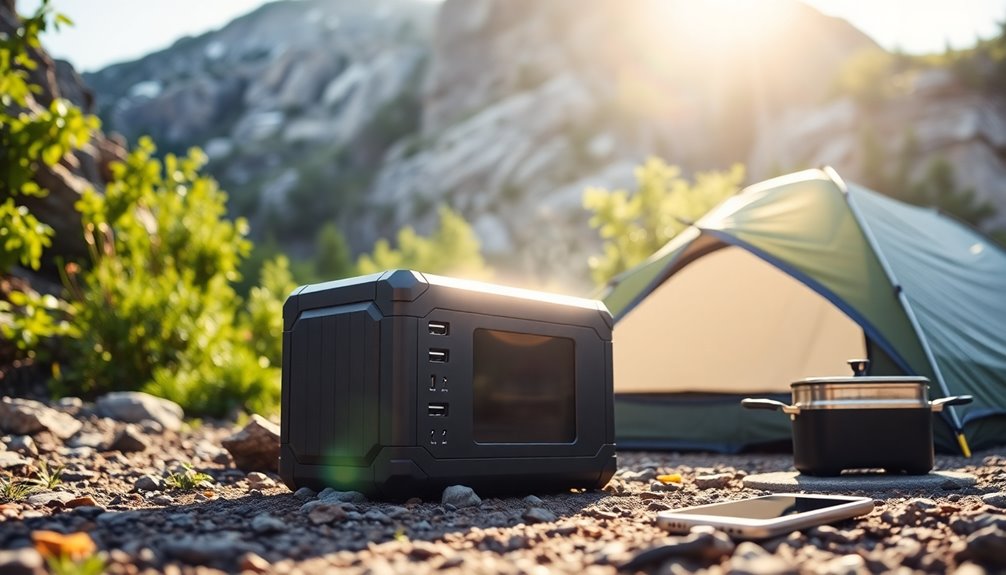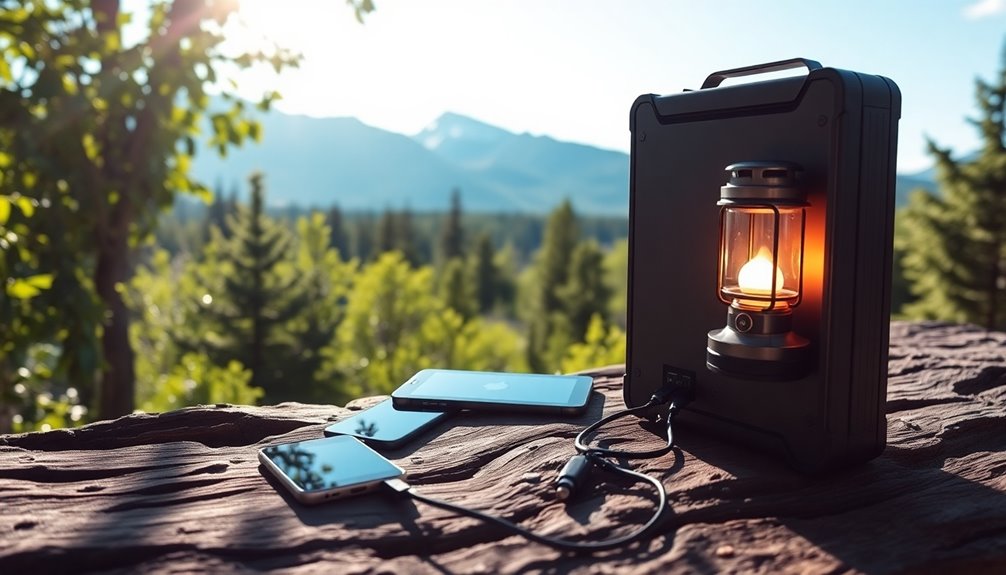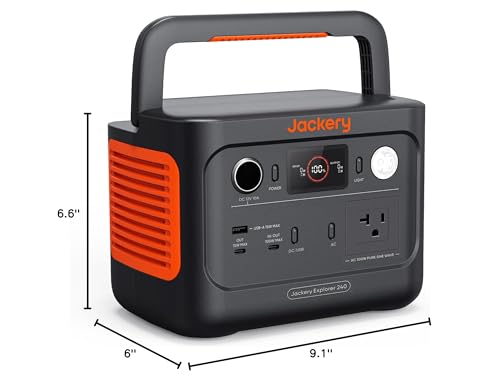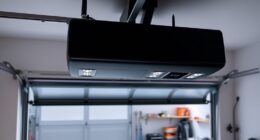I've explored the vibrant world of portable power stations, and I've found them essential for off-grid adventures and emergencies. The 14 best options for 2025 feature varying capacities, lightweight designs, and advanced battery technologies like LiFePO4. Whether you're camping or need backup power, these stations offer diverse output options, fast charging speeds, and smart features for convenience. Each model caters to different needs, making it easy to find one that suits you. If you're curious about the specific models and factors to evaluate, stick around for some valuable insights!
Key Takeaways
- Explore various models with capacities ranging from 88Wh to over 1,000Wh to suit different power needs for off-grid living and outdoor activities.
- Evaluate lightweight designs (3.2 lbs to 27 lbs) for easy transportation during camping, emergencies, or travel.
- Consider fast charging capabilities, with many models reaching 80% in about 50 minutes for efficient power supply.
- Look for advanced battery technologies like LiFePO4 for durability and over 3,000 cycles, ensuring long-term use and safety.
- Review multiple output options (AC, USB-A, USB-C) and smart features for enhanced versatility and convenience in powering devices.
EF ECOFLOW Portable Power Station Delta 2
The EF ECOFLOW Portable Power Station Delta 2 is a game-changer for anyone needing reliable power on the go, whether you're camping, RVing, or looking for backup power at home. Weighing just 27 pounds, it packs a mighty punch with a 1024Wh LiFePO4 battery, providing a continuous output of 1800W and a peak of 2700W. With 15 outlets, I can charge multiple devices simultaneously. The rapid-charging capabilities are impressive—charging from 0 to 80% in just 50 minutes! Plus, the option to expand its capacity up to 3kWh with extra batteries makes it incredibly versatile. I appreciate its safety features and long lifespan, ensuring it's ready for any adventure or emergency.
Best For: The EF ECOFLOW Portable Power Station Delta 2 is best for campers, RV enthusiasts, and homeowners seeking reliable backup power solutions.
Pros:
- Rapid charging: Charges from 0 to 80% in just 50 minutes.
- Versatile power options: 15 outlets allow simultaneous charging of multiple devices.
- Long lifespan: Over 3000 cycles with LiFePO4 technology ensures durability and reliability.
Cons:
- Weight: At 27 pounds, it may be cumbersome for some users to carry.
- Price: Higher upfront cost compared to traditional generators.
- Limited solar charging speed: Charging via solar panels can take longer under less-than-ideal conditions.
Bailibatt Portable Power Station 300W
If you're someone who enjoys camping or needs a reliable power source for emergencies, the Bailibatt Portable Power Station 300W is an excellent choice. Weighing just 4.6 pounds, it's incredibly portable, making it easy to take on any adventure. With a robust battery capacity of 69600mAh, it can power up to eight devices simultaneously, perfect for charging laptops, phones, and even a mini-fridge. The pure sine wave AC outlets guarantee your sensitive electronics are safe. Plus, the built-in BMS system keeps everything monitored, adding an extra layer of safety. While the charging time is around 8-9 hours, its compact size and reliable output make it a great companion for off-grid living or unexpected outages.
Best For: Outdoor enthusiasts, campers, and individuals seeking a reliable power source for emergencies.
Pros:
- Compact and lightweight design makes it easy to transport.
- Powerful output allows simultaneous charging of up to eight devices.
- Built-in safety features ensure protection for sensitive electronics.
Cons:
- Slow charging speed may be inconvenient for some users.
- Potential for defective units to arrive, as noted by customer feedback.
- Recharge needed every 1-2 months if not in use, which may require additional maintenance effort.
Jackery Portable Power Station Explorer 300
For anyone seeking a reliable power source while camping or during emergencies, the Jackery Portable Power Station Explorer 300 stands out. With its 293Wh lithium-ion battery, it's lightweight at just 7.1 pounds, making it easy to transport. You'll appreciate the 300 watts of power (500 watts starting) and multiple output options, allowing you to charge up to six devices simultaneously—perfect for your drone, MacBook, or LED lights. The integrated MPPT controller guarantees efficient solar charging, while pass-through charging lets you power devices even while recharging. Users rave about its ease of use and rapid recharge time, getting to 80% in just two hours. Whether you're on a road trip or facing a blackout, this power station won't let you down.
Best For: Individuals seeking a portable and reliable power source for camping, outdoor activities, or emergency backup situations.
Pros:
- Lightweight and portable design makes it easy to transport at just 7.1 pounds.
- Multiple output options allow charging of up to six devices simultaneously, including laptops and drones.
- Rapid recharge time of 80% in just two hours, enhancing usability in urgent situations.
Cons:
- Limited capacity of 293Wh may not be sufficient for larger appliances or extended use.
- Requires additional solar panel for optimal solar charging, which is sold separately.
- Starting wattage of 500 watts may not support devices with higher power demands.
Jackery Explorer 1000 v2 Portable Power Station
Looking for reliable power on the go? The Jackery Explorer 1000 v2 Portable Power Station might just be what you need. With a robust 1,070Wh battery, it delivers 1,500W of AC output and can surge up to 3,000W, making it perfect for powering devices like fridges for 8-15 hours. Weighing only 23.8 lbs and featuring a compact design with a foldable handle, it's easy to transport. Plus, it charges from 0% to 100% in just one hour! The Jackery App lets you control charging modes and monitor battery status. While some users wish for more accessories, like dust caps, its performance and reliability make it highly recommended for camping and emergencies. You won't be disappointed!
Best For: The Jackery Explorer 1000 v2 is best for campers, outdoor enthusiasts, and those seeking a reliable power source for emergencies.
Pros:
- Fast Charging: Can charge from 0% to 100% in just one hour, ensuring quick availability of power.
- Versatile Ports: Equipped with multiple charging options, including USB-C, USB-A, and AC ports for simultaneous device use.
- Long Lifespan: Maintains over 70% capacity after 4,000 charge cycles, making it a durable choice.
Cons:
- Missing Accessories: Some users noted the absence of a solar charge cable and dust caps for the outlets.
- Weight: While compact, it may still be considered heavy for some users compared to smaller power stations.
- Limited Additional Features: Users suggested improvements like more LED lights and additional monitoring options.
MARBERO Portable Power Station 88Wh for Camping and Emergency Use
The MARBERO Portable Power Station 88Wh stands out as an ideal choice for campers and outdoor enthusiasts seeking reliable power on the go. Weighing just 3.2 lbs and featuring a compact design, it's super easy to carry on my adventures. With its lithium battery and 120W peak power AC outlet, I can charge my devices quickly—up to 80% in just two hours! It also allows me to charge multiple devices simultaneously, thanks to its eight output ports. Plus, the solar compatibility means I can harness the sun's energy when I'm off-grid. The built-in LED flashlight adds extra utility, especially during emergencies. Overall, it's a dependable companion for camping and home backup needs!
Best For: Outdoor enthusiasts and campers looking for a portable and reliable power source for their devices.
Pros:
- Compact and lightweight design (3.2 lbs) for easy transport.
- Rapid charging capability, reaching 80% in just 2 hours.
- Multiple output ports (8 in total) allow for simultaneous charging of various devices.
Cons:
- Limited power duration when used with heavy appliances.
- Some users reported issues with reliability after limited use.
- May require additional solar panels for off-grid charging solutions.
Anker 521 Portable Power Station (256Wh, 300W)
If you're an outdoor enthusiast seeking reliable power on your adventures, the Anker 521 Portable Power Station stands out with its impressive 256Wh capacity and 300W output. Weighing just 8.2 pounds and measuring 8.5 x 5.67 x 8.33 inches, it's remarkably portable. With two AC outlets, two USB-A ports, a USB-C port, and a car outlet, I can easily charge multiple devices simultaneously. The InfiniPower technology guarantees durability, promising a lifespan of about 10 years. While it handles high-wattage appliances with a surge output of 600W, I've noticed some limitations with solar charging. Overall, the five-year warranty and solid customer support make it a dependable choice for my camping trips and emergency power needs.
Best For: Outdoor enthusiasts and individuals needing reliable portable power for camping trips, emergency backup, or charging multiple devices.
Pros:
- Lightweight and portable design makes it easy to carry on outdoor adventures.
- Multiple charging options including AC, USB-A, USB-C, and car outlet for versatile device compatibility.
- Durable InfiniPower technology ensures a long lifespan of about 10 years.
Cons:
- Solar charging may have limitations in terms of efficiency and input power.
- AC output limited to 300W, which may not support higher-wattage appliances consistently.
- Some users report issues with solar charging performance, affecting overall usability in certain situations.
OUPES Exodus 1200 Portable Power Station
Designed for outdoor enthusiasts and those seeking reliable backup power, the OUPES Exodus 1200 Portable Power Station stands out with its impressive capacity of 992Wh. I love the versatility it offers, with three AC outlets, two USB-A ports, and two USB-C ports, making it easy to power multiple devices at once. The surge power of 3600W is a game-changer for high-drain appliances like refrigerators and power tools. Weighing only 23 lbs, it's compact enough for camping trips or home backup. Plus, the LiFePO4 battery lasts over 3500 cycles, ensuring longevity. I appreciate the smart app control for monitoring usage and the built-in UPS functionality to protect my electronics during outages. Overall, it's a reliable choice for off-grid energy solutions.
Best For: Outdoor enthusiasts, campers, and individuals in need of reliable backup power for devices during emergencies or off-grid living.
Pros:
- High capacity (992Wh) and surge power (3600W) suitable for powering multiple high-drain devices simultaneously.
- Lightweight and portable design (23 lbs) makes it easy to transport for camping or travel.
- Smart app control and built-in UPS functionality enhance user experience and protect sensitive electronics.
Cons:
- Recharge time can be lengthy (up to 2 hours to reach 80%) when not using solar power.
- Limited to 3500+ life cycles before dropping to 80% capacity, which may not meet all users' long-term needs.
- Higher initial investment compared to traditional battery options.
Anker SOLIX C300 Portable Power Station (288Wh)
For anyone who loves outdoor adventures or needs a reliable backup during emergencies, the Anker SOLIX C300 Portable Power Station (288Wh) stands out with its impressive combination of power and portability. Weighing just 9.02 pounds and measuring 6.46 x 6.34 x 9.45 inches, it's easy to carry. With a capacity of 288Wh and 300W output (600W surge), it powers everything from laptops to small appliances effortlessly. Plus, the fast charging capabilities mean you can recharge it to 80% in just 50 minutes via a wall outlet. I appreciate the quiet operation at 25dB and the user-friendly display that keeps me informed. Overall, this power station is highly recommended for anyone needing dependable energy on the go.
Best For: Those seeking a lightweight and efficient portable power solution for outdoor activities, travel, and emergency situations.
Pros:
- Lightweight and highly portable design.
- Fast charging options, reaching 80% in just 50 minutes.
- Quiet operation at a noise level of only 25dB.
Cons:
- Limited capacity (288Wh) may restrict simultaneous usage of multiple devices.
- Carrying strap not included, which some users find inconvenient.
- May not be suitable for larger appliances requiring more power.
BLUETTI AC180 Portable Power Station
The BLUETTI AC180 Portable Power Station stands out as an ideal choice for outdoor enthusiasts and those in need of reliable backup power. With a robust 1152Wh LiFePO4 battery, it delivers 1800W of continuous power and peaks at 2700W, making it capable of running everything from lights to coffee makers. I love how quickly it charges—just an hour with a 1440W AC input or 2.8-3.3 hours with solar panels. Its 11 versatile outlets guarantee I can connect multiple devices simultaneously. Weighing about 16kg, it's portable and easy to transport. The LCD screen provides real-time data, and the responsive customer service adds to the overall positive experience. It's a reliable companion for camping trips and emergency situations alike.
Best For: Outdoor enthusiasts and individuals seeking reliable backup power solutions during emergencies or camping trips.
Pros:
- Fast Charging: Fully charges in just one hour with AC input and efficiently charges with solar panels.
- Versatile Outlets: Offers 11 different outlets, allowing multiple devices to be powered simultaneously.
- Sturdy Build: Compact and portable design with high-quality construction for durability.
Cons:
- Weight: Weighs around 16kg, which may be heavy for some users to carry.
- MPPT Limitations: Current handling is limited to 10A, which could affect solar charging efficiency.
- Self-Consumption: Users may need to consider self-consumption when using small loads, potentially requiring a larger unit for extended use.
GRECELL Portable Power Station 300W
If you're someone who loves outdoor adventures or needs a reliable backup power source during emergencies, the GRECELL Portable Power Station 300W is an excellent choice. With a capacity of 288Wh and the ability to power up to eight devices simultaneously, it's perfect for laptops, CPAP machines, or mini-refrigerators. I appreciate its multiple output options, including a 60W USB-C port that charges my devices twice as fast as standard ports. The upgraded Battery Management System guarantees safety, while dual silent cooling fans keep it at the right temperature. Plus, I've heard great things about GRECELL's customer support, making this power station a solid investment for anyone looking for reliable off-grid energy solutions.
Best For: Outdoor enthusiasts and individuals needing a reliable backup power source during emergencies.
Pros:
- Fast charging capabilities with USB-C PD 60W, charging devices over twice as fast as standard outputs.
- Multiple output options allowing simultaneous powering of up to eight devices, including laptops and mini-refrigerators.
- Strong customer support and warranty process, ensuring satisfaction and prompt resolution of issues.
Cons:
- Limited capacity for devices with total power requirements exceeding 330W.
- Weight may be a consideration for some users looking for ultra-portable options.
- Fan noise during operation might be noticeable in quiet environments.
Jackery Explorer 240 v2 Portable Power Station
Looking for a reliable power source during your outdoor adventures? The Jackery Explorer 240 v2 Portable Power Station is a fantastic choice. With its 256Wh LiFePO4 battery, it delivers 300W AC output and 100W USB-C output, making it perfect for charging everything from smartphones to mini fridges. Weighing just 7.7 lbs and measuring 9.1 x 6 x 6.6 inches, it's super portable. I love the fast charging options; it fully charges in just 2 hours via an AC outlet. Plus, it boasts impressive safety features, including shock resistance and fire protection. Whether I'm camping or facing an emergency, this power station has proven reliable time and again. It's a must-have for any off-grid enthusiast!
Best For: Outdoor enthusiasts and off-grid adventurers seeking a reliable and portable power source for their electronic devices.
Pros:
- Fast charging capabilities, fully charging in just 2 hours via AC outlet.
- Lightweight design at 7.7 lbs, making it easy to transport.
- Multiple charging ports allow for simultaneous device charging.
Cons:
- Requires a DC8020 to USB-C adapter for solar panel compatibility.
- Limited AC output of 300W may not support larger appliances.
- Price point may be higher compared to basic power banks.
Portable Power Station 600W
For anyone seeking a reliable and versatile power solution while camping or traveling, the Portable Power Station 600W stands out with its 600W pure sine wave output and lightweight design. Weighing just 7.7 lbs, it's compact enough to carry anywhere. With a 293Wh lithium battery, it powers essential devices like laptops, CPAP machines, and drones effortlessly, even supporting up to eight devices at once. Its fast recharge feature gets you from 0% to 80% in just two hours. Plus, the built-in BMS guarantees safe operation, monitoring voltage and temperature. I love the clear LCD screen that keeps me informed about the status. Whether for emergencies or outdoor adventures, this power station is a solid choice for portable energy needs.
Best For: Those seeking a portable and reliable power solution for camping, travel, and emergencies.
Pros:
- Lightweight and compact design (7.7 lbs) for easy transport.
- Fast recharge capability, reaching 0% to 80% in just two hours.
- Can power multiple devices simultaneously, accommodating up to eight devices at once.
Cons:
- Limited to devices with low wattage; may not support larger appliances.
- Additional equipment required for solar or vehicle charging not included.
- Not suitable for all power needs, particularly high-demand devices.
Jackery Portable Power Station Explorer 500
The Jackery Portable Power Station Explorer 500 is perfect for outdoor enthusiasts seeking reliable power on the go. With a robust 518Wh lithium battery pack, it features one AC outlet, three USB-A ports, and two DC ports, allowing me to charge multiple devices simultaneously. I appreciate its compact design, weighing just 13.32 lbs and easy to carry with its solid handle. It operates quietly, which is a bonus when I'm camping or on a road trip. The built-in LED light is handy for nighttime use. Plus, it's compatible with the Jackery SolarSaga 100W solar panel for eco-friendly charging. Overall, it's versatile enough for various power needs, making it an excellent choice for adventures or emergency backup at home.
Best For: Outdoor enthusiasts and individuals seeking reliable portable power for camping, road trips, or emergency backup at home.
Pros:
- Versatile charging options with one AC outlet, three USB-A ports, and two DC ports for simultaneous device charging.
- Compact and lightweight design makes it easy to transport, perfect for outdoor activities.
- Eco-friendly charging capability when paired with the Jackery SolarSaga 100W solar panel.
Cons:
- Limited AC power capacity with a maximum output of 500W, which may not support larger appliances.
- Long charging times when using AC outlet (7.1 hours) or solar panel (10.5 hours) can be inconvenient for quick recharges.
- Weight (13.32 lbs) may be a bit heavy for some users looking for ultra-portable options.
ALLWEI Portable Power Station 300W
If you're an outdoor enthusiast or someone who values preparedness during power outages, the ALLWEI Portable Power Station 300W is an ideal companion. Weighing just 6.5 pounds and measuring 9 x 4.7 x 7.8 inches, it's incredibly portable. With a capacity of 280Wh, it powers everything from CPAP machines to laptops through its nine output ports. I love the versatility of charging options—AC, car, or solar panel—giving me the freedom to recharge in various environments. The solid build, ergonomic handle, and LED light with three brightness levels make it user-friendly in any situation. Plus, with a 4.5-star rating from nearly 1,800 users, it's clearly a reliable choice for anyone seeking off-grid energy solutions.
Best For: Outdoor enthusiasts and individuals seeking reliable backup power solutions during emergencies or power outages.
Pros:
- Versatile charging options including AC, car, and solar panel for convenience.
- Lightweight and portable design with ergonomic handle for easy transport.
- High user satisfaction with a 4.5-star rating from nearly 1,800 reviews.
Cons:
- Limited to 300 watts output, which may not support high-draw devices simultaneously.
- Charging time can be lengthy depending on the method used (up to 6.5 hours for AC).
- May require additional warranty purchase for long-term investment protection.
Factors to Consider When Choosing Portable Power Stations

When I think about choosing a portable power station, several factors come to mind that can really make or break my experience. I consider the power capacity I need, how portable it is, and the variety of output ports it offers. Plus, I can't forget about charging speed and the type of battery technology involved.
Power Capacity Requirements
Choosing the right power capacity for your portable power station is essential to ensuring it meets your needs. Start by calculating the total wattage of all devices you plan to power at the same time. It's vital that the portable power station can handle this combined load without exceeding its output limits.
When evaluating options, look at the capacity measured in watt-hours (Wh). For instance, a station with a 256Wh capacity can run a 50W device for about five hours. Don't forget to check both continuous output (rated wattage) and peak output (surge wattage); some devices need extra power to start, which means you may need a station that can handle those higher surges.
Think about how long you'll need to use your devices. If you want to run a 45W fridge for eight hours, for example, you'll need a power station with at least 424Wh (45W multiplied by 8 hours). Finally, consider how many devices you'll charge simultaneously, as some stations support multiple outputs while others don't, influencing your overall capacity planning.
Weight and Portability
After determining the power capacity you need, it's time to think about weight and portability. The weight of portable power stations can vary greatly, ranging from as light as 3.2 lbs for compact models to over 27 lbs for larger units. This variation directly affects how easily you can transport your power station, especially during outdoor activities or emergencies.
When I'm selecting a power station, I pay close attention to design features like ergonomic handles and compact dimensions. These aspects make a noticeable difference when I'm carrying the unit around. Smaller models, typically under 10 lbs, are perfect for short trips and light-duty tasks, while heavier options are better suited for more demanding power needs, such as camping or home backup.
I've found that some models strike a good balance between weight and capacity, allowing me to choose a power station that meets my specific needs without sacrificing portability. Additionally, considering the dimensions and overall design is essential for fitting the power station into my vehicle or storage spaces when traveling. Ultimately, finding the right balance of weight and portability enhances my off-grid experience.
Charging Speed Options
One of the top factors I consider is charging speed when evaluating portable power stations. A quick recharge can be a game changer, especially when I'm out in the field or during emergencies. Most models now offer AC wall charging, which can recharge from 0% to 80% in about 50 minutes. That's incredibly efficient. Some even have fast charging capabilities, reaching full capacity in just 1 to 1.5 hours.
I also pay attention to solar charging options, as they can vary considerably. Some power stations support up to 500W solar input, allowing for a full charge in as little as 2.8 to 3.3 hours under ideal sunlight. This can really cut down my downtime during outdoor adventures.
However, I've learned that car charging isn't ideal for quick refills, often taking over 10 hours to reach full capacity. That's why I appreciate models with pass-through charging, letting me power devices while the unit itself is charging. It's a fantastic feature for extended trips, ensuring I stay powered up without missing a beat.
Output Ports Variety
When I evaluate portable power stations, the variety of output ports is vital because it determines how many devices I can power at once. A diverse range of ports, including multiple AC, USB-A, USB-C, and DC outputs, allows me to charge and run different devices simultaneously, enhancing versatility. I find that some power stations can support up to eight devices at once, making them perfect for group outings or emergency situations.
It's also important for me to have pure sine wave AC outlets, as they safely power sensitive electronics like laptops and medical devices without risking damage. Additionally, I appreciate the flexibility that input options like car ports and solar charging capabilities provide. They accommodate various circumstances, whether I'm on a road trip or camping in the wilderness.
Fast-charging USB-C ports are another feature I look for, as they greatly reduce charging times for compatible devices. This means I can keep my essential electronics powered on-the-go without waiting around. Ultimately, the right combination of output ports makes all the difference in how effectively I can use a portable power station.
Battery Technology Type
Having a variety of output ports is just one aspect of choosing a portable power station; the type of battery technology also plays a significant role in overall performance and reliability. I've found that battery chemistry can dramatically affect how long your power station lasts and how safely it operates. For instance, LiFePO4 batteries provide over 3,000 cycles, while Nickel Manganese Cobalt (NMC) batteries usually offer only 1,500 to 2,000 cycles.
The stability of LiFePO4 batteries makes them a safer choice, as they're less prone to thermal runaway. I appreciate that they can maintain their charge for up to 350 days without significant degradation, which is handy for standby power situations. Plus, with their ability to operate in extreme temperatures—from -4°F to 176°F—they're perfect for diverse environments.
When I choose a portable power station, I always consider the intended usage scenario, whether it's for off-grid living, emergency backup, or outdoor adventures. Battery technology isn't just about performance; it's an essential factor that can make or break your power experience in the great outdoors.
Safety Features Included
While considering a portable power station, I always prioritize safety features that can protect both the unit and my devices. A Battery Management System (BMS) is vital; it monitors voltage, current, and temperature, providing safeguards against overload, overcharging, and short circuits. This aspect gives me peace of mind when I'm out in the field.
I also look for models with surge protection features to handle sudden power spikes. These features can prevent damage to my sensitive electronics, which is significant when I'm relying on my power station for essential devices. Automatic shut-off mechanisms are another great feature; they prevent overheating and guarantee safe operation during extended use.
Built-in cooling fans are equally important to maintain an ideal temperature, reducing the risk of overheating and extending the lifespan of the unit. Finally, I always check for certifications like UL or TÜV SÜD. These indicate that the product has undergone rigorous safety testing, assuring me of its reliability and adherence to safety standards. Investing in a portable power station with these safety features not only protects my devices but also enhances my overall experience with off-grid energy solutions.
Warranty and Support
Choosing a portable power station can feel overwhelming, especially when you factor in warranty and support options. It's important to look for a longer warranty period, typically ranging from 1 to 5 years, as this often reflects a manufacturer's confidence in their product's durability. When I'm considering a power station, I always check what the warranty covers. Some warranties might protect specific components, while others cover the entire unit. Understanding these details can save you headaches later.
Additionally, customer support is vital. Many brands offer 24/7 assistance, which can be invaluable if you run into troubleshooting issues or maintenance questions. I also find it helpful to read customer reviews about support responsiveness and effectiveness. This gives me insights into how well the company takes care of its customers.
If you want extra peace of mind, some manufacturers provide extended warranties or protection plans for an added cost. This option can be worth it for long-term use. By considering these factors—warranty length, coverage, and support options—you'll be better equipped to choose the right portable power station for your needs.
Frequently Asked Questions
How Do I Determine the Right Wattage for My Needs?
When I'm figuring out the right wattage for my needs, I first list all the devices I want to power. I check their wattage requirements, usually found on the labels or manuals. Then, I add up those numbers, considering any extra for surge power. I always make sure to choose a power station with a little more capacity than my total to avoid running out of juice when I need it most.
Can Portable Power Stations Be Used While Charging?
Absolutely, portable power stations can be used while charging. I've done it myself on camping trips and during power outages. Just keep in mind that using them while charging might slow down the charging process, as some energy is being drawn for your devices. I always check the manufacturer's guidelines, but in my experience, it's a handy feature that lets me keep my devices powered up without missing a beat.
What Is the Lifespan of a Portable Power Station Battery?
The lifespan of a portable power station battery usually ranges from 500 to 2,000 charge cycles, depending on the type and quality of the battery. I've found that lithium-ion batteries tend to last longer, often providing reliable power for several years with proper care. It's essential to avoid extreme temperatures and overcharging to maximize their lifespan. Regular maintenance and mindful usage can really make a difference in how long your power station lasts.
Are Portable Power Stations Safe for Indoor Use?
I've often wondered if portable power stations are safe for indoor use. Generally, they can be safe, especially those designed with safety features like overcharge protection and ventilation systems. However, I always make it a point to check the manufacturer's guidelines. It's essential to avoid using gas-powered models indoors due to carbon monoxide risks. I recommend placing any unit in a well-ventilated area to guarantee safety while enjoying the convenience they offer.
How Do I Maintain My Portable Power Station?
Maintaining a portable power station is like nurturing a plant; a little care goes a long way. I always keep my unit clean and dry, checking for any signs of wear. Regularly charging it, even when I'm not using it, helps keep the battery healthy. I store it in a cool, dry place, and avoid extreme temperatures. By following these steps, I'm confident my power station will serve me well for years.
Conclusion
In a world where staying connected is as essential as breathing, choosing the right portable power station can feel like finding a lighthouse in a storm. Each option I've explored here has its unique strengths, catering to various needs and adventures. Whether you're camping under the stars or preparing for an emergency, there's a perfect power solution waiting for you. So, power up, embrace your off-grid adventures, and let nothing dim your spark!

























